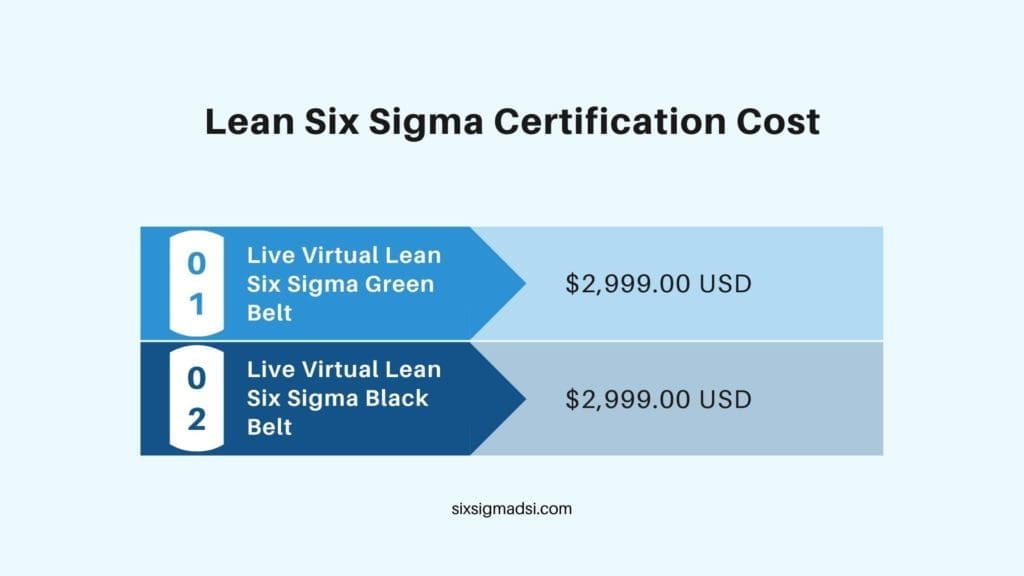Table of contents
Lean Six Sigma Certification Cost
The cost of lean six sigma employee certification and training should not be a problem if your employer offers it as part of a Lean Six Sigma deployment material. If you choose to become LSS certified and trained for professional and personal development, the money will come out of your wallet.
This article will highlight the various options for certification and training provided by external organizations. You should not base your decisions solely on the quoted price by the organization. Q: What is the difference in value and worth? A: Value is what you get when someone exchanges money for a product or service. Value is an intrinsic value that is not affected by external factors like supply or demand. It is crucial to any LSS program. It helps determine whether a product or project is worth the effort. This concept is sometimes confused with “profitability,” but it focuses on a project’s impact on the entire organization. It is possible to make more informed decisions and positively impact an organization’s bottom line by considering customer and organizational needs. This will depend on the program’s quality and the provider’s reputation and credibility. Employers place a high value on the provenance of your certification, as they are more likely to trust programs that have been well-respected and successful.
Lean Six Sigma Certification Cost
Lean Six Sigma is a combination of Six Sigma and Lean methods. Ungar says Six Sigma traditionally calls for black belt engineers to use statistics to solve process problems. Lean, however, encourages team collaboration to reduce waste in a process.
Six Sigma and Lean Six Sigma are sometimes interchangeable terms by some certifying organizations. Some offer separate Six Sigma or Lean Six Sigma belt certification tracks. For example, the Council for Six Sigma Certification recommends Six Sigma training for “most people”, and Lean Six Sigma for military personnel and public sector workers.
Reviewing the course content, you can choose between Six Sigma or Lean Six Sigma training material certifications.
Six Sigma Certification Levels
Six Sigma certification can be divided into six levels. Each level indicates a professional’s knowledge, skills, experience, and role in a project. These levels correspond to black belts in martial arts. Except for a master’s black belt, there are no prerequisites. You can therefore start at any level that feels most comfortable to you.
Six Sigma White Belt
The Six Sigma fundamentals are the focus of the white belt. The white belt learns about team members’ roles and how they can help improve efficiency in a company. They are familiar with the DMAIC process and other tools. Their focus is usually on waste reduction.
Depending on the program, this level can require up to eight hours of classes and an exam.
Six Sigma Yellow Belt
The Six Sigma Yellow belt expands on the basic principles of the white belt. Yellow belts can apply Six Sigma in their workplaces. They may also be able to create process maps or improve processes. These process maps outline the steps and parameters of a process.
They are also familiar with the principles of information collection. Although yellow belts are not expected to lead a team, they could be subject matter experts and can serve as a support role for green or black belt project leaders.
The yellow belt is more time-intensive than the white belt. Courses take around 20 hours, plus an exam.
Six Sigma Green Belt
Six Sigma green belts are for professionals who create, identify and improve processes. They can lead small-scale projects and assist black belt leaders.
Green belt projects may focus on quality improvement, such as reducing errors and collecting and analyzing data. Six Sigma projects may take 25% to 50% of their time.
This certification can take between two and five weeks to complete. It also requires an exam of six sigma training material.

Six Sigma Black Belt
Six Sigma black belts can train and lead teams of yellow, green, or white straps. This is a different skill set than green belts. These leaders are full-time Six Sigma, project managers. These leaders may manage complex projects that include organization-wide modifications and efforts for increased quality, productivity, and revenue.
Black belts must also have a solid understanding of statistical analysis, process improvement, and statistical analysis. They must also be able to lead and motivate others, as their responsibilities include mentoring and assigning roles to teammates.
Campe says Six Sigma black belt training usually lasts at least four weeks. The third and fourth weeks focus on organization-specific information and projects. Some programs offer up to 16 weeks of training. Black belts must also pass an exam.
Six Sigma Master Black Belt
A master black belt is the leader of Six Sigma project teams and mentors black and green belts. Master black belts must have at most five years’ experience in Six Sigma black belt training. They are often viewed as consultants to the Six Sigma team, providing guidance and solutions for technical problems.
Black belts can guide strategy and identify projects. They also communicate with executives or senior-level employees. They may also be able to teach others Lean Six Sigma principles and update training information.
You could be awarded a master blackbelt certification in seven weeks, depending on your chosen program. Also, you will need to pass an exam.
Six Sigma Certification: Why?
Six Sigma certification gives you the tools to solve complex problems across many industries. Campe says that learning Lean Six Sigma and DMAIC, in particular, will prepare you for three roles: mechanic, doctor, and detective. You can diagnose, fix and investigate problems.
These skills allow employees to initiate and complete projects that improve efficiency, quality, and the bottom line.
Six Sigma Certification for Employees
Ungar states that problem-solving is a learned skill, and Lean Six Sigma black and green belt certification programs can help you solve problems effectively.
Earning Six Sigma certification and applying Six Sigma principles to your business can help you stand out. Campe states that leaders may be attracted to professionals who can demonstrate tangible results from their projects. You could also gain extensive knowledge about your company, which could help you to build a reputation for being an expert.
Six Sigma Certification for Enterprises
According to Ungar, Lean Six Sigma certification offers two significant benefits to organizations. It aims to create a “culture of continuous improvement” by providing design and process tools that can help improve an organization’s results.
Six Sigma can be used to increase efficiency and quality. Crown Equipment Corp. has saved over $1 million by combining Six Sigma with Lean methods in a case. The savings made by the company offset the cost of training 12 green belts.
LIVE VIRTUAL Classroom Training

Online Lean Six Sigma Green Belt Courses:
Live Virtual Lean Six Sigma Green Belt
Dates: 1/9/2023 – 1/13/2023
Live (Instructor Led) Virtual Training
Price: $2,999.00 USD
Live Virtual Lean Six Sigma Green Belt
Dates: 2/20/2023 – 2/24/2023
Live (Instructor Led) Virtual Training
Price: $2,999.00 USD
Live Virtual Lean Six Sigma Green Belt
Dates: 3/20/2023 – 3/24/2023
Live (Instructor Led) Virtual Training
Price: $2,999.00 USD
Live Virtual Lean Six Sigma Green Belt
Dates: 4/17/2023 – 4/21/2023
Live (Instructor Led) Virtual Training
Price: $2,999.00 USD
Online Lean Six Sigma Black Belt Courses:
Live Virtual Lean Six Sigma Black Belt
Dates: 1/16/2023 – 1/20/2023
Live (Instructor Led) Virtual Training
Price: $2,999.00 USD
Live Virtual Lean Six Sigma Black Belt
Dates: 3/13/2023 – 3/17/2023
Live (Instructor Led) Virtual Training
Price: $2,999.00 USD



















